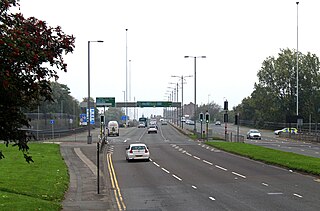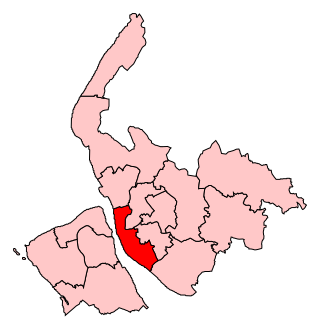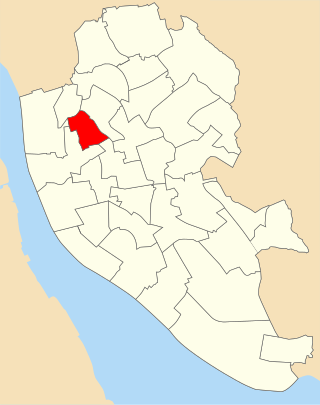
Liverpool is a city and metropolitan borough in Merseyside, northwest England. It had a population of 496,770 in 2022. The city is located on the eastern side of the Mersey Estuary, adjacent to the Irish Sea, and is approximately 178 miles (286 km) from London. Liverpool is the fifth largest city in the United Kingdom, the largest settlement in Merseyside and part of the Liverpool City Region, a combined authority with a population of over 1.5 million.

Ellesmere Port is a port town in the Cheshire West and Chester borough in Cheshire, England. Ellesmere Port is on the south eastern edge of the Wirral Peninsula, six miles north of Chester, on the bank of the Manchester Ship Canal. The town had a population of 61,090 in the 2011 census. Ellesmere Port also forms part of the wider Birkenhead urban area, which had a population of 325,264 in 2011.

Bootle is a town in the Metropolitan Borough of Sefton, Merseyside, England, which had a population of 51,394 in 2011; the wider Parliamentary constituency had a population of 98,449.

Everton is a district of north Liverpool, England, and part of the Liverpool Walton constituency. It is bordered by Vauxhall to the west, Kirkdale to the north, and Anfield to the north-east. Historically in Lancashire, at the 2011 Census the population was 14,782.

Croxteth is a suburb of Liverpool, Merseyside, England, and a Liverpool City Council Ward. Although housing in the area is predominantly modern, the suburb has some notable history. At the United Kingdom 2011 Census it had a population of 14,561. Croxteth is within the boundaries of the traditional county Lancashire.

Dingle is an inner city area of Liverpool, Merseyside, England. It is located to the south of the city, bordered by the adjoining districts of Toxteth and Aigburth. At the 2001 Census, the population was recorded at 13,246.

Scotland Road, known locally as Scottie Road, is the section of the A59 road situated near the docks in the Vauxhall district of north Liverpool, England.

Liverpool Riverside is a constituency represented in the House of Commons of the UK Parliament since 2019 by Kim Johnson, who is a member of the Labour Party.

Kirkdale is a district of Liverpool, Merseyside, England, and a Liverpool City Council ward that covers both Kirkdale and Vauxhall. At the 2011 Census, the population was 16,115.

The history of Liverpool can be traced back to 1190 when the place was known as 'Liuerpul', possibly meaning a pool or creek with muddy water, though other origins of the name have been suggested. The borough was founded by royal charter in 1207 by King John, made up of only seven streets in the shape of the letter 'H'. Liverpool remained a small settlement until its trade with Ireland and coastal parts of England and Wales was overtaken by trade with Africa and the West Indies, which included the slave trade. The world's first commercial wet dock was opened in 1715 and Liverpool's expansion to become a major city continued over the next two centuries.

Central was an electoral division of Liverpool City Council in the Liverpool Riverside Parliamentary constituency.

The architecture of Liverpool is rooted in the city's development into a major port of the British Empire. It encompasses a variety of architectural styles of the past 300 years, while next to nothing remains of its medieval structures which would have dated back as far as the 13th century. Erected 1716–18, Bluecoat Chambers is supposed to be the oldest surviving building in central Liverpool.

Kirkdale ward was an electoral division of Liverpool City Council centred on the Kirkdale and Vauxhall areas of Liverpool.

Everton ward was an electoral division of Liverpool City Council in the Liverpool Walton Parliamentary constituency.

Liverpool city centre is the commercial, cultural, financial and historical centre of Liverpool and the Liverpool City Region, England. Different definitions of the city centre exist for urban planning and local government, however, the border of Liverpool city centre is broadly marked by the inner city districts of Vauxhall, Everton, Edge Hill, Kensington and Toxteth.
Elections to Liverpool Town Council were held on Saturday 26 December 1835.

Vauxhall ward is an electoral division of Liverpool City Council centred on the Vauxhall area of the city.

Breckfield ward was an electoral district of Liverpool City Council from 1895 until 2004. It was part of the Everton and Anfield districts of Liverpool.

Waterfront North ward is an electoral district of Liverpool City Council within the Liverpool Riverside constituency.


















